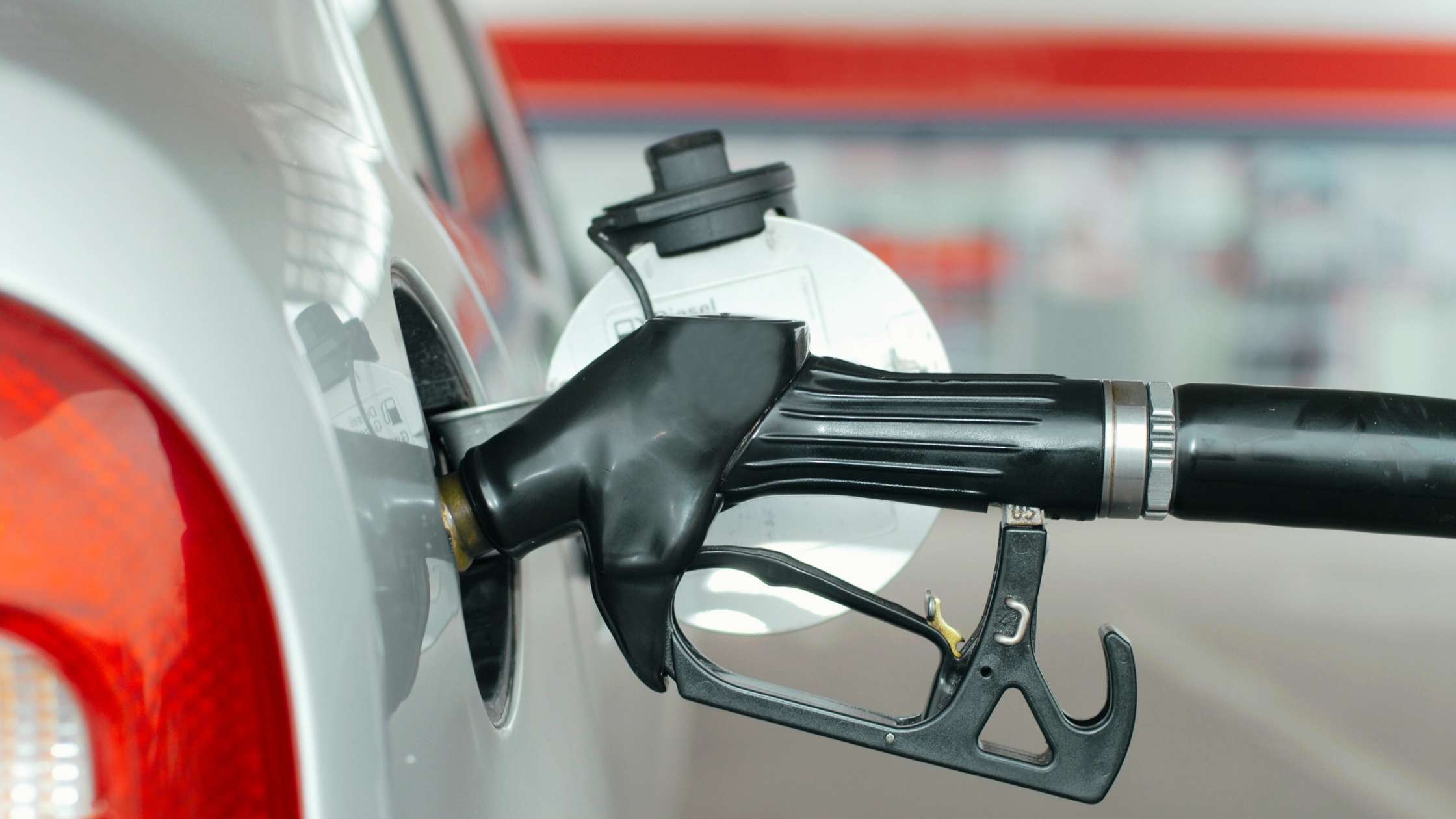
For business owners and fleet managers, setting up fuel cards may feel like all the necessary security measures are in place. Spending controls are implemented, drivers can only purchase fuel, and your fuel card program appears to be running smoothly. But then you discover, sometimes months later, that an employee has exploited the parameters of the program, resulting in significant fuel theft. How can activity like this go undetected?
This guide will explain the key reasons why employee fuel theft often goes unnoticed, identify the most common tactics used to misuse company fuel cards, and provide a detailed checklist to help you implement a fuel card program designed to minimize the risk of internal theft.
Table of Contents
- Why employee fuel theft often goes unnoticed
- Top employee fuel theft tactics (and how to stop them)
- Fuel card program checklist to prevent employee fuel theft
Why Employee Fuel Theft Often Goes Unnoticed
Employee fuel card theft is easy to miss if you’re not looking in the right places or you don’t have the proper controls in place to prevent it. Fuel prices go up and down all the time and most businesses see seasonal variations in their fuel usage. So getting a bill that is a few hundred dollars more than usual probably won't catch your attention. Even if it does, you review the invoice and nothing looks out of the ordinary because usually employee fuel theft will happen one tank at a time. It's going to be difficult to catch a few hundred dollars of theft per month on an invoice that may be thousands of dollars.
So how do you stop employee fuel card theft? First you need to understand the common ways employees misuse fuel cards.
Top Employee Fuel Theft Tactics (and How to Stop Them)
Here are the most common ways employees steal fuel with company fuel cards and what you can do to stop it.
Filling Up a Personal Vehicle
An employee may use a company fuel card to fill up their personal vehicle. This is often the most straightforward form of fuel card theft.
Solution: Set fuel card time frame limits that match employees' shifts so that the fuel cards do not work before or after work hours. When they are driving company vehicles during their shifts there will be no way to fuel their personal vehicles since they can't drive two vehicles at once.
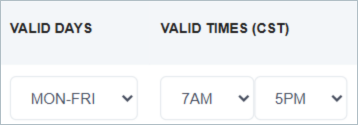
Fueling Multiple Vehicles on One Transaction
While fueling the company vehicle, the employee is joined by a friend or family member with another car. After the employee fuels the company vehicle, they pass the fuel hose to the other person to continue fueling the second vehicle under the same transaction. Since the fueling continues under the same transaction, it appears as a single legitimate purchase in your fuel card reports and invoice. Sometimes they even use this tactic to fill up a stranger's car at a heavily discounted rate in exchange for cash.
Solution: Require employees to enter the odometer at the pump before every fuel purchase so your fuel card reports and invoices will calculate the MPG. When you review vehicle MPG, lower MPG numbers will flag employees that may be doing this since they are buying fuel for two vehicles. For example, a box truck that usually gets 12MPG may start reading 8MPG if the driver is using this tactic.

Filling Gas Containers
When the employee is fueling up the company vehicle, they pump fuel into into containers like gas cans, drums, or tanks during the same transaction for later resale or personal use. This tactic is a little riskier than meeting a friend at the gas station since the employee will have to sneak a container in the company vehicle.
Solution: Use the same odometer tracking solution described above.
Employee Request a New Fuel Card and Keeps the Old Fuel Card
Employee states their fuel card is malfunctioning or worn out and the manager orders a new fuel card and tells the employee to use the old fuel card until the new card arrives. When the new card arrives, the manager passes out the new fuel card and forgets to cancel the old card. The employee then uses the old fuel card for personal use or gives it to someone else to use.
Solution: Always cancel old fuel cards before handing out new fuel cards. Check your active fuel card list to make sure there are no duplicate fuel cards.
Employee Resigns or is Terminated and Leaves with an Active Fuel Card
Driver turnover is high in almost all industries. People are coming and going all the time. It's not uncommon for fleet managers to forget to cancel a fuel card and later find out they are paying for a driver's fuel when they left the company months ago.
Solution: During the exit interview process, always collect and cancel fuel cards.
Fuel Card Program Checklist to Prevent Employee Fuel Theft
Here's a checklist to help secure your fuel card program and protect your company from employee fuel card theft.
1. Set Up Your Fuel Cards to Collect the Right Data
For every fuel transaction you need to know the driver, vehicle, and odometer at the time of transaction. This may sound basic, but you'd be surprised how many people have their fuel cards set up with a vehicle name and don't track the driver that is fueling the vehicle or they have generic fuel card descriptions such as "Company Fuel Card 1" and have no idea which driver or vehicle is attached to it..
This step is foundational to catching employee fuel theft because you need this data to identify theft patterns and who is responsible for it. If you have generic names on your cards or you aren't tracking which driver is fueling which vehicle, then you won't be able to identify differences in vehicle or driver usage which is the primary way to find employee fuel theft. And even if you did find theft, it's going to be difficult to enforce repercussions when an employee name is not tied to the transactions.
This is what a transaction will look like if your fuel cards are collecting the right data.
| Date | Time | Card | Driver | Vehicle | Vehicle Description | Product | Quantity | Price | Amount | Odom | MPG | Location |
| 6/10/2025 | 5:12AM | 2369755 | Alex Martinez |
0074 | 2023 F-150 | UNL | 15.65 | $3.592 | $56.21 | 150,685 | 18.3 | Oceanside, CA |
2. Set Fuel Card Spend Limits Based on Vehicle Tank Size
Make a list of tank sizes (gallon capacity) for every vehicle in your fleet, then set the spend limits for the associated fuel cards to match the vehicle tank capacities. For example, for a 2023 F-150 that has a 26 gallon tank and the average cost for gasoline is $3 per gallon, set the dollars per transaction limit and dollars per day limit to $80. Doing this will prevent having extra funds left on the card that could be used to fuel other vehicles.
| Vehicle | Tank Size | Average Fuel Price | Max Fuel Needed Per Fill |
| 2023 F-150 | 26 gallons | $3 | $80 |

3. Cancel Unneeded Fuel Cards Immediately
Login to your fuel card portal to cancel a fuel card immediately if:
- A fuel card is lost or stolen
- A driver resigns or is terminated
- You sell a company vehicle
- Upon receiving a replacement fuel card
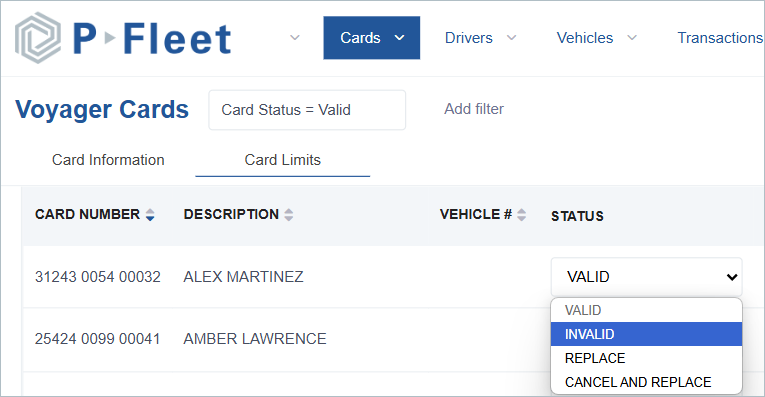
4. Regularly Review Your Active Fuel Card List
Login to your fuel card portal to review your active fuel card list at least once per month. This will catch any instances where you may have missed canceling an unneeded fuel card.
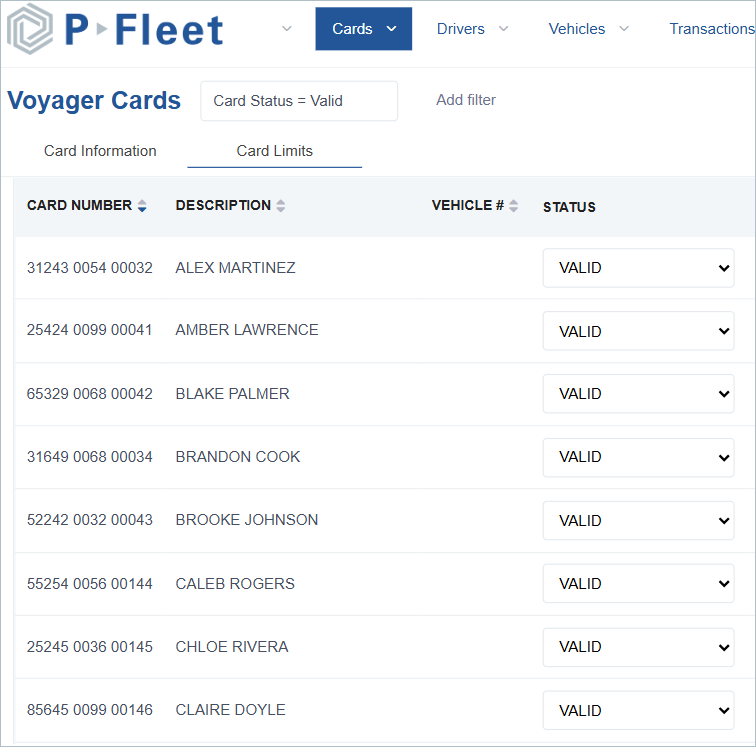
5. Monitor Your Transactions
Monitor your fleet's fuel card transactions daily to catch employee fuel theft as it is happening. Add it to your daily check list to take 3-5 minutes to review fuel card transactions at some point in your day.

6. Set Up Fuel Card Alerts
You can receive fuel card alerts via email when a driver purchases something outside of the normal parameters. For example, if a fuel card is set up for diesel and you have product exception alerts activated, you will receive an email immediately if anything other than diesel is purchased. Then you can take the alert and ask your driver what happened.
Fuel Card Alerts
- E-receipts
- Product exceptions - purchasing wrong type of fuel
- Driver transaction errors
- Fueling outside of business hours or days
- Fueling away from designated locations
- Alerts when specific cards are used
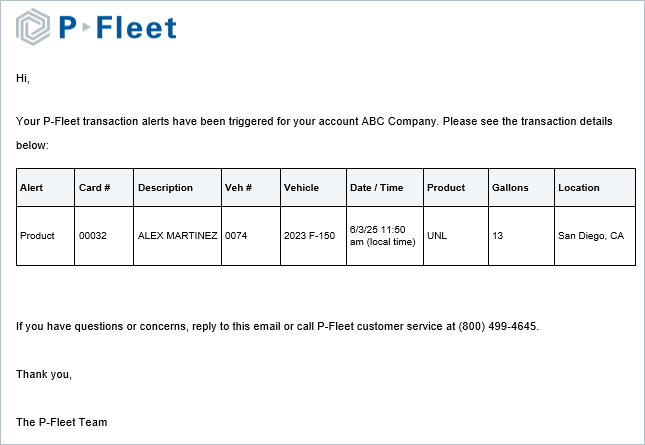
7. Create a Driver Fuel Card Policy
A driver fuel card policy is a formal document that helps prevent employee fuel theft by setting clear rules on how and when fuel cards can be used. By requiring drivers to acknowledge the policy in writing, it creates accountability and states the consequences for misuse which deters theft. Overall, it fosters a culture of responsibility and transparency, helping fleet managers reduce the risk of employee fuel theft.
8. Treat Company Fuel Cards Like Personal Debit Cards
It's baffling how many companies treat their fuel cards like a pair of office scissors, just floating around the office for anyone to use, at anytime. Yet no one would just leave their debit card at the dispatch desk or in the breakroom. If your fuel cards are assigned to drivers, your drivers need to understand that their fuel card is to remain with them in a safe place at all times. If your fuel cards are assigned to vehicles, they should always remain in a secure place in the vehicle.
Explore How You Can Stop Employee Fuel Theft with P-Fleet
Take a self guided tour of P-Fleet's fuel card portal to see how you can manage your fuel cards, check transactions, and download reports that will help you stop employee fuel card theft. Our fuel card portal allows customer's to manage both P-Fleet Voyager and CFN fuel cards. If you're interested in opening a fuel card account you can apply online in just a few minutes.





